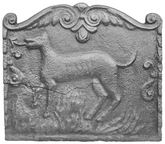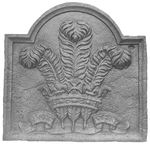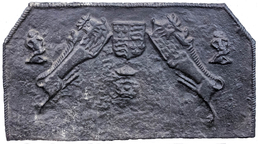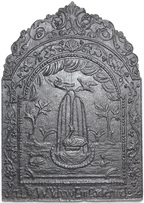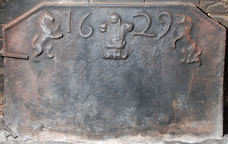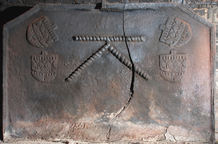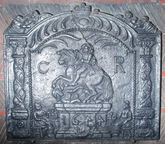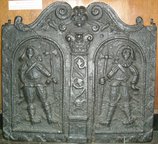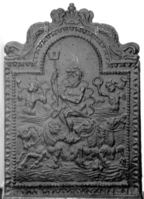-
851
Description: Rectangular with mirrored floriate scrolled top; simulated overlapping tile edging at sides, with fillet bottom edge; a mythical salamander in the form of a dog with an arrow-shaped tongue, standing among flames; a stapled scroll inside the left and right edges.
Notes: This fireback was used to create a composite fireback design on a plate at Rivers Farmhouse, Ardingly (no. 13).
- Decoration tags:
- rectangular (shape)
- simulated overlapping tile (edging)
- whole carved pattern
- mythological
- animals
- objects
Manufactured: in the mid-17th century in the Weald area of England.
Current location: not known.
Citation: Lloyd, N., 1925, 'Domestic Ironwork I', Architectural Review, 58, pp. 58-67.
- Attached to series:
- Stapled scroll series
- Brede group
-
853
Description: Arched rectangular shape; cavetto edging; three ostrich feathers issuing from a royal coronet; motto banner below.
Notes: The badge of the Prince of Wales; perhaps cast during the Commonwealth period; a copy at Rottingdean Grange (no. 670) has added initials.
Copies of this fireback are known.
Inscription: ICH [DIEN]
- Decoration tags:
- rectangular with round arch (shape)
- cavetto (edging)
- whole carved pattern
- heraldic
- royal
- text
- objects
Manufactured: in the mid-17th century in the Weald area of England.
Current location: not known.
Citation: Lloyd, N., 1925, 'Domestic Ironwork I', Architectural Review, 58, pp. 58-67.
- Attached to series:
- Prince of Wales firebacks
-
125
Description: Canted rectangle; twisted rope edging (top and sides); top centre, Tudor royal shield between lion passant guardant to right and lion passant guardant sinister to left, both diagonally placed; below, a crowned rose; to left and right, an 'imp' with arms down, facing left.
Notes: One of a large series incorporating royal heraldic stamps. Canterbury Auction Galleries sale, 29 Nov 2017, lot 939 (£300).
Copies of this fireback are known.
Arms: Tudor royal arms of England
- Decoration tags:
- rectangular with canted top corners (shape)
- rope (edging)
- carved stamps
- heraldic
- armorial
- animals
- humans
Manufactured: in the mid-16th century in the Weald area of England.
Current location: not known.
Citation: Lloyd, N., 1925, 'Domestic Ironwork I', Architectural Review, 58, pp. 58-67.
- Attached to series:
- Royal series
-
240
Description: Arched rectangular shaped central panel with bead-and-pellet edging on a wide fillet; ground with birds, and trees behind; in the centre a circular fountain rim with a swan on a plinth surrounded by water, with jets of water rising from the swan’s mouth and descending on either side; above, a heron and a goose fly to the left; under the arch, swags of drapery; arched rectangular shaped border with fillet edging, symmetrical floral fronds descending from a scallop shell, top centre, with a looed 'W' in each shoulder; inscription at base between date; on top, symmetrical scrolled plant tendrils. A single central vertical plankline.
Notes: One of a group of firebacks, all of the same date, some of which have the same Welsh inscription which translates as 'God is our strength'. All incorporate the looped 'W' motif which may be intended to identify the pattern maker. The design is adapted from an illustration of fountain no. XXXIX, 'Les Cannes et le Petit Barbet' in Labyrinthe de Versailles by Sébastien le Clerc (1677); the flying heron and duck are copied from illustrations by Francis Barlow (c1626-1704) or from engravings of his work by Wenceslaus Hollar (1607-77).
Copies of this fireback are known.
Inscription: 17 DVW Ydyw Ein Cadernid 24
- Decoration tags:
- 'Dutch' (shape)
- fillet (edging)
- whole carved pattern
- planklines
- pictorial
- architectural
- text
- animals
- objects
Manufactured: in 1724 in England.
Current location: Newton House, Dinefwr, Llandeilo, Carmarthenshire, Wales.
Museum number: F83.116 (part of the Welsh National History Museum museum group)
Citation: Lloyd, N., 1925, 'Domestic Ironwork I', Architectural Review, 58, pp. 58-67.
- Attached to series:
- 1724 series
- Welsh inscription series
- British 'Dutch' style firebacks
-
244
Description: Canted rectangle; twisted rope edging (top and sides); stamp of three ostrich feathers within a coronet, between the two parts of the date, with lion and unicorn supporters outside date.
Notes: The ostrich feathers are the badge of the Prince of Wales. There is no known significance of the year 1629 with that title, the birth of the prince (later Charles II) being in the following year. The date was probably added to a recasting of the plate. The lack of detail in the modelling indicates this has been recast several times.
Copies of this fireback are known.
Inscription: 16 29
- Decoration tags:
- rectangular with canted top corners (shape)
- rope (edging)
- carved stamps
- individual numbers
- heraldic
- text
- animals
Manufactured: in 1629 in the Weald area of England.
Current location: in private hands, Chailey, East Sussex, England.
Citation: Lloyd, N., 1925, 'Domestic Ironwork I', Architectural Review, 58, pp. 58-67.
- Attached to series:
- Prince of Wales' feathers series
- Prince of Wales firebacks
-
56
Description: Flattened arched rectangular shape; cavetto moulded edge all round; Stuart royal arms with lion and unicorn supporters, crown, garter and motto; CR initials placed separately outside supporters; date split either side of crown.
Notes: A much-copied variant with the additional initials, I T, above the date and on either side of the crown.
Copies of this fireback are known.
Inscription: I T / 1635 / C R / HONI SOIT QVI MAL Y PENSE / DIEV ET MON DROIT
Arms: English Stuart royal (Charles I )
- Decoration tags:
- rectangular with round arch (shape)
- cavetto (edging)
- whole carved pattern
- planklines
- armorial
- royal
- text
Manufactured: in 1635 in the Weald area of England.
Current location: Dyrham Park, Dyrham, Gloucestershire, England.
Museum number: 453291 (part of the National Trust museum group)
Citation: Lloyd, N., 1925, 'Domestic Ironwork I', Architectural Review, 58, pp. 58-67.
- Attached to series:
- Carolean royal armorial firebacks
- Stuart royal armorial firebacks
-
871
Description: Canted rectanular shape, with stepped fillet edging (top and sides); upper centre, horizontal ?leather twist above an inverted ?leather twist 'V'; on each side, a shield-shaped stamp repeated twice, the upper one of each being angled so its side is parallel to the canted edging.
Notes: The design on the shield is not recognisably heraldic in form, and appears to incorporate a possible pictorial element although this is not clear; the inverted 'V' shape may have apotropaic significance.
Copies of this fireback are known.
- Decoration tags:
- rectangular with canted top corners (shape)
- stepped fillet (edging)
- simple stamps
- carved stamps
- apotropaic
- objects
Manufactured: in the late-16th century in England.
Current location: in private hands, East Grinstead, West Sussex, England.
Citation: Lloyd, N., 1925, 'Domestic Ironwork I', Architectural Review, 58, pp. 58-67.
- Attached to series:
- Miscellaneous stamp firebacks
-
280
Description: Arched rectangular shaped central panel, bead edging (top and sides), pedestal bearing a supine male figure with headband being trampled by a horse, facing left, mounted by a rider with long hair, facing to the front; on each side of the plinth is a seated figure wearing a hat, with a basket of fruit; above the rider are crescent lines representative of clouds; the inscription is split either side of the horse; the date (‘7’ rotated and, with ‘4’, reversed) is on the die of the pedestal; arched rectangular shaped border, fillet edging, on each side a Solomonic column with vine decoration; in the arch, symmetrical parallel curved lines with a central oval cartouche beneath a crown; on top of each shoulder of the plate a figure in repose.
Notes: The equestrian figure is derived from the statue of Charles II erected in Stocks Market, London, in 1672. Originally to be of Jan Sobieski, later king of Poland, riding down a Tatar, it was altered to represent Charles, and the Tatar’s face was changed to that of Oliver Cromwell; the statue attracted a fair degree of derision. The statue is now at Newby Hall, near Ripon, North Yorkshire. Another version (no. 464), probably by the same pattern-maker, omits a date and has altered initials.
Copies of this fireback are known.
Inscription: C R / 1674
- Decoration tags:
- 'Dutch' (shape)
- cavetto (edging)
- whole carved pattern
- individual numbers
- pictorial
- historical
- architectural
- text
- animals
- humans
Manufactured: in 1674 in England.
Current location: Chequers, Ellesborough, Buckinghamshire, England.
Citation: Lloyd, N., 1925, 'Domestic Ironwork I', Architectural Review, 58, pp. 58-67.
- Attached to series:
- Carolean 'Dutch' series
- Commemorative firebacks
-
81
Description: Rectangular with two mirrored scrolls on top, a lion’s face between; bas-relief semi-circle edging (sides and bottom); central pilaster with vine scrolling, Corinthian capital, initials on the pedestal; on either side, an arched alcove, each with a halberdier in mid-17th century clothes, their feet pointing to the middle.
Notes: Stylistically similar to the Lenard fireback (no. 429), the initials also appear on other firebacks. All known examples of this fireback are poorly modelled and cast. A rare version (no. 400) has different edging and lacks the pattern-maker’s initials.
Copies of this fireback are known.
Inscription: IM
- Decoration tags:
- rectangular with ornate arch (shape)
- fillet (edging)
- whole carved pattern
- planklines
- pictorial
- architectural
- text
- humans
Manufactured: in the early- to mid-17th century possibly at Brede Furnace in the Weald area of England.
Current location: Guildford Museum, Guildford, Surrey, England.
Museum number: S.7108 (part of the Guildford Museum museum group)
Citation: Lloyd, N., 1925, 'Domestic Ironwork I', Architectural Review, 58, pp. 58-67.
- Attached to series:
- IM series
- Brede group
-
110
Description: Arched rectangular shaped central panel with fillet and bead edging, Neptune/Poseidon, holding a trident in his right hand, sitting in a scallop shell drawn by four mythical sea horses, behind are two mermaids; arched rectangular shaped border with ovolo egg and dart edging; above, two symmetrical dolphins with a clam shell between.
Notes: Typical type of firebacks produced in Germany for the Dutch market; the central panel was made separately for insertion into different borders; this border is a relatively simple type. Formerly part of the Ade Collection (from Grove Hill, Hellingly, Sussex).
Copies of this fireback are known.
- Decoration tags:
- 'Dutch' (shape)
- ovolo, egg and dart (edging)
- carved pattern panels
- mythological
- animals
- humans
Manufactured: in the mid- to late-17th century possibly in the Siegerland area of Germany.
Current location: Hastings Museum and Art Gallery, John's Place, Bohemia Road, Hastings, East Sussex, England.
Museum number: HASMG: 1952.51.36 (part of the Hastings Museum museum group)
Citation: Lloyd, N., 1925, 'Domestic Ironwork I', Architectural Review, 58, pp. 58-67.
- Attached to series:
- 'Dutch' Miscellaneous Firebacks
- 'Dutch' Dolphin series
